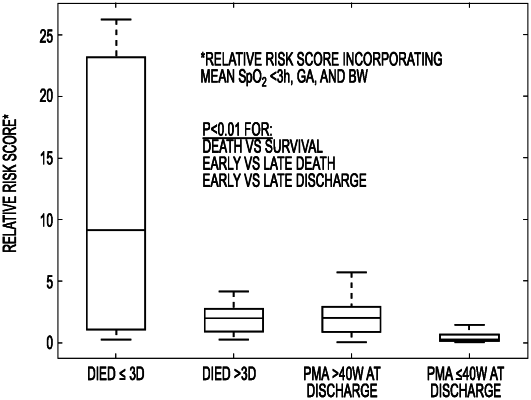| CPC A61B 5/7275 (2013.01) [A61B 5/1455 (2013.01); A61B 5/14551 (2013.01); A61B 5/48 (2013.01); G16H 50/30 (2018.01); A61B 2503/045 (2013.01); A61M 2230/205 (2013.01); G16H 15/00 (2018.01)] | 14 Claims |

|
1. A method for generating pulse oximetry predictive scores (POPS) for predicting occurrence of predetermined pathologies in a preterm infant, the method comprising:
based on Heart Rate (HR) and oxygen saturation (Sp02) data sensed directly from the preterm infant by a pulse oximetry sensor, calculating by at least one processor and over different time periods specific to a predetermined pathology one or more of:
(a) mean and standard deviation of HR and Sp02,
(b) cross-correlation of HR and Sp02,
(c) HR decelerations,
(d) HR and Sp02 entropy,
(e) hypoxia and hyperoxia, or
(f) any combination of (a) through (e);
generating by said at least one processor pulse oximetry predictive scores (POPS) via a predictive algorithm which incorporates cross-correlation of HR and Sp02 calculated on archived pulse oximetry data of multiple preterm infants to analyze the calculated data;
outputting said generated pulse oximetry predictive scores (POPS) on a display monitor to a user; and
predicting the predetermined pathology of said preterm infant based on the generated POPS, wherein the pathology includes at least one of intraventricular hemorrhage (IVH), late-onset sepsis (LOS), necrotizing enterocolitis (NEC), bronchopulmonary dysplasia (BPD), or retinopathy of prematurity (ROP);
based on the outputting of the POPS, informing said user of an opportunity to perform an action selected from the group consisting of:
identifying said preterm infant as a highest risk infant and performing additional surveillance of or therapeutic intervention on said preterm infant;
identifying said preterm infant for participation in a clinical trial based on a risk profile associated with said POPS; and
treating said preterm infant for said pathology.
|